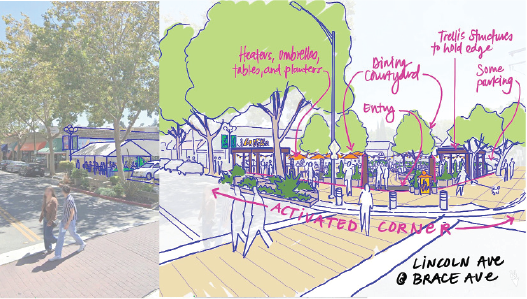As the COVID-19 pandemic began decimating small businesses and depopulating streets in San José, the mayor and City Council created a lifeline for restaurants and their patrons in the form of the Al Fresco Initiative. The temporary effort to put more seating on sidewalks, streets, and in off-street private parking lots continues to be popular as a mechanism for advancing economic recovery and reinvigorating streets. A new SPUR report, Making Al Fresco Work: Leveraging San José’s Temporary Outdoor Dining Initiative to Enliven Neighborhoods and Create Economic Stability, notes that the initiative has begun to transform San José’s urban environment in ways that are consistent with the city’s larger goals of creating vibrant commercial corridors and walkable neighborhoods. The report, developed with Outside Voices and Kristen Hall City Design and informed by key stakeholders and a task force, argues that outdoor dining could have an even more positive impact if the city leveraged the lessons learned from the temporary initiative in developing a permanent, citywide program. We talked with Erika Pinto, SPUR’s San José planning policy manager, about proposed strategies for improving on San Jose’s current outdoor dining review processes and about the role of al fresco spaces in transforming the city’s public realm.
If the city were to create a permanent al fresco program, what do you think that program could accomplish?
A permanent program would establish San José as a city with a lively outdoor dining scene and allow local restaurateurs and bar owners to grow their businesses and adapt to changing economic landscapes. In addition, a permanent program would promote new street life and foster an ongoing process of collaboration between the city and residents to meet evolving community needs. The temporary Al Fresco Initiative supported public life and well-being, and we believe that it has incredible potential to align San José communities, stakeholders, and city leadership behind a vision for more connected and vibrant streets as well as a commitment to improved city processes that facilitate business and neighborhood interventions.
The report calls for a permanent program to make some improvements on the temporary Al Fresco Initiative. How?
The pandemic showed that liberating government from its own rules can allow for big, transformative change. The initiative really did help some restaurants to stay afloat. But more businesses would have liked to have established al fresco spaces during the pandemic — and many would like the opportunity to do so now. Our report details four strategies for remedying the lack of clarity, predictability, and affordability that has discouraged many businesses from participating in the temporary Al Fresco Initiative. We based these strategies on lessons from the initiative and the city’s many existing plans and programs for its streets and public spaces.
What are the four strategies?
First, transition the temporary Al Fresco Initiative to a permanent program and direct resources — funds and staff — to make it a success.
Second, make the program easy to navigate and predictable by improving its interdepartmental coordination, creating a user-friendly program interface, and developing and promoting pre-approved and flexible al fresco space designs.
Third, make the program affordable: Changing requirements so that more applications qualify for an over-the-counter permit, identify funding sources other than permitting fees to offset the city’s permitting costs, and explore grant funding for program participants.
And fourth, scale up the program by identifying and resourcing liaisons to amplify it, developing success metrics to track and publish progress, establishing a program database and resource center, and taking a program-enabling approach.
How did SPUR engage stakeholders to arrive at these strategies?
In August 2022, we kicked off a research and outreach effort to begin formulating strategies and recommendations for a permanent al fresco program. We developed an advisory committee and conducted interviews with city staff, business leaders, community groups, commercial real estate developers, urban designers, and entrepreneurs to reimagine the Al Fresco Initiative. We hosted two workshops with business owners, city leaders, and neighborhood associations to better understand perspectives on the initiative. We also hosted a workshop with city staff to discuss their vision for a permanent al fresco program and their thoughts on next steps. The insights and recommendations presented in our report have been informed by these workshops, conversations, and interviews.

The report contextualizes the proposed program within a larger placemaking effort.
That’s right. A permanent al fresco program would be aimed at leveraging small-scale interventions such as putting seats on streets and in parking lots across the city. Facilitating outdoor dining in San José would serve as a springboard for placemaking — an approach to urban design that prioritizes people over infrastructure. The purpose of this approach is to create public spaces that are not merely utilitarian but that promote social interaction.
Carefully considered placemaking benefits everyone.
First, it can be a relatively low-cost tool for economic recovery and development. Well-designed and well-programmed public spaces, including al fresco dining spaces and permanently closed streets, can attract economic activity to currently underutilized infrastructure like sidewalks and parking lots. By reviving downtowns and other commercial areas hollowed out by pandemic-era business closures and remote and hybrid work, these spaces can spur private investment.
Second, placemaking increases quality of life for residents. It enlivens neighborhoods that have seen little investment (public or private), particularly those where foot traffic may be discouraged by safety concerns, poor physical connections to other neighborhoods and downtown, and lack of venues for social and small-scale entrepreneurial activities. By making it easy for people to gather, public spaces can increase well-being and inspire civic pride and participation.
Viewed in the context of placemaking, a permanent al fresco program takes on greater significance and urgency. The strategies recommended in our report not only will facilitate a more equitable program by lowering administrative and cost hurdles to participation but also will pave the way for development of public spaces that increase economic security and pay other social dividends.